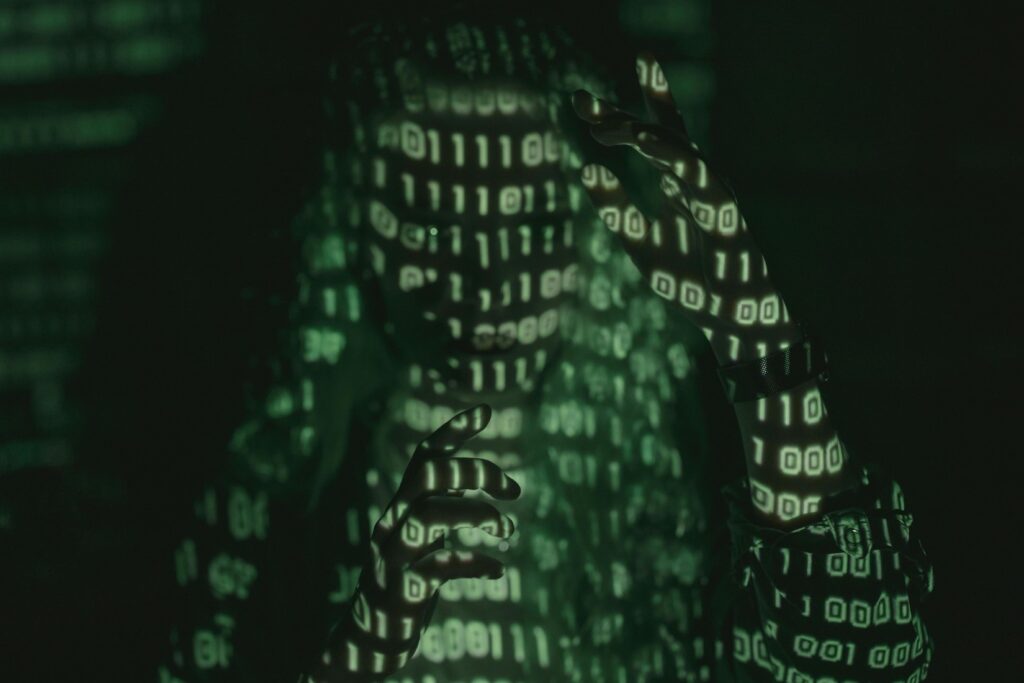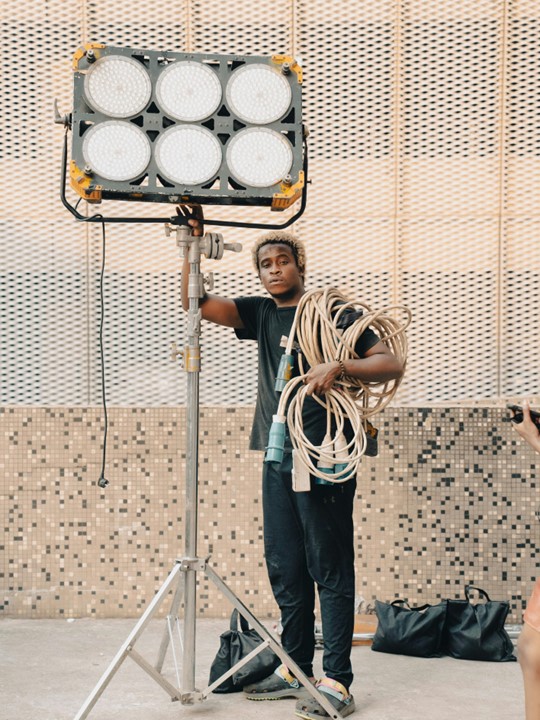You can’t swing a mike boom on the set today without hitting AI. Not that it’s bad, but maybe techie folks (and “perhaps” bosses) are trying a little hard to show off how good it is. We, for one, have no desire to sit down and watch a “totally AI project.” Why? No emotion. No feelings. No guts. People make movies/shows, not tools.
You should try building a boat with hand tools after a couple of shots of Jack.” – Special Agent Leroy Jethro Gibbs, “NCIS,” Belisarius Productions, 2003–present
Back in 1964, US Supreme Court Justice Potter Stewart was asked to describe his test for obscenity (pornography), to which he replied something to the effect, “I can’t define it, but I know it when I see it.” That’s about where we are right now when folks are trying to describe how good/bad, beneficial/evil AI is/is going to be for the entertainment industry. Some “experts” say it’s going to democratize content creation, making the production of great/entertaining shows/movies available to everyone.
But then again, we’re still struggling to understand creativity.
In 1954, Robert Gober unveiled his “Three Urinals” masterpiece, and some art connoisseur paid $3.5 million for it. We’ve only seen pictures of this work of art, but one of the first things we noticed was that the things weren’t even plumbed, so they were sort of useless to 99.9% of the folks who looked at them. We walked into the men’s room after returning from a business trip, and there were three urinals in a row. They all worked, and we’re pretty sure the airport commission didn’t pay $3.5 million for them. And, the airport urinals are seen and more appreciated annually by more people than Gober’s. His work doesn’t make us laugh or cry, scream or cheer. Instead, it….
So, which is more creative?

Experts claim that AI is going to speed, simplify, and improve project plot/script writing, which seems at best, in our opinion, impossible. Of course, our tech experts probably disagree with Ernest Hemingway as well, who has said, “Good writing is true writing. If a man is making a story up, it will be true in proportion to the amount of knowledge of life that he has and how conscientious he is, so that when he makes something up, it is as it would truly be.
“Writing is something that you can never do as well as it can be done. It is a perpetual challenge, and it is more difficult than anything else that I have ever done—so I do it. And it makes me happy when I do it well.”
So, what does AI feel after it wraps up a writing project? About the same as our computer sending us a love note… nada! Even techies agree that AI sucks at empathy and emotions because you can’t reduce them to a bunch of 1 and 0 codes and the men, women, and kids who are packing theaters wouldn’t notice… would they?

Jeff Katzenberg, former head of DreamWorks Animation and now head of WndrCo, a tech investment firm, has said that AI is going to streamline projects, reduce production time, and save project owners millions of dollars. When he says AI can replace 90% percent of the jobs in animation production, slash the time required to create a project like the latest hit Inside Out 2 (ironically, about emotions and feelings), and dramatically reduce the production (5.5 years, $175 million) budget, we believe him. After all, he knows that stuff.
To reinforce Katzenberg’s statements, Bain & Company pointed out that taking full advantage of AI in something like a modest family comedy could reduce the time and cost by 5–10%. For studios and streamers that are struggling to turn a profit on their content, that’s nothing to sneeze at. However, there are a lot of places along the creation/production cycle where people can streamline activities and are reducing time/money budgets without replacing the heart/soul of a project.
WBD shareholders would like to see management turn the ship around and deliver more than just tax savings by shelving projects and staff reductions. Even though shareholders love Bob Iger, they’d like to see the company’s family fare, sci-fi blockbuster sequels, and streaming activities turn red ink to black. The boss of Paramount’s three bosses would probably like to see the former entertainment powerhouse regain its respected position in the industry. While Netflix, the industry disrupter, is profitable (thanks to the really smart use of subscriber viewing data to disrupt content selection, production, and distribution), what senior management team wouldn’t like to be more profitable?
Combine GenAI with Nvidia’s powerful new GPUs, Epic’s insanely great game engine, and really creative content, quality can be more efficiently and effectively produced and delivered. We appreciate the potential and recognize the challenges/issues AI presents for the content industry. The challenge will be to use it selectively and carefully. Folks like Bain and AI executives reassure us that the technology won’t replace our heroes, heroines, actors, and stars. Not that we’re dismissing them from the equation, but they are what, 10% of the creative team?
Actors like Scarlett Johansson, Tom Hanks, George Clooney, Julia Roberts, and the rest of the A- (and B-, C-) list actors already have expensive lawyers who have spelled out every detail in their contracts that ensure their images/voices will be protected and paid for in perpetuity. They and their heirs will receive residuals whenever/wherever their likenesses are used. There are icons we have lost, like Chadwick Boseman, Brandon Lee, Robin Williams, and others, who, at some level, people would like to see return to the big and bigger screen but….
It’s the other 90% of the creative arena where GenAI application needs to be addressed—the writers, coordinators, cinematographers, grips, lighters, artists, animators, production/post crew, and trades. These are the areas where OpenAI and the rest of the tech arena feel they can dramatically improve by unlocking production capacity, transforming timelines, unlocking creative capacity, making it more efficient, and delivering greater returns for the struggling industry.
The men/women who keep the show/movie industry rolling aren’t the actors or directors whose names we see on the credits. Instead, it’s the hourly, daily, and project people in every area who produce the goods people enjoy. If AI takes over their skilled work so “junior” people can do the execution, too much of the industry is lost.

In the US, Statista estimated that there were more than 441,700 men/women working in the industry. Globally, there is at least five times that number in advanced and emerging countries who work on a production project or hourly basis. They’re the foundation, the infrastructure, the heart of the industry that gets the least attention and is hurt first when strikes shut the industry down, as the trades did last year and this year.
Automation has been, and will continue to be, vital in the content creation industry. Animated shorts and shows/films have made significant strides forward by automating many of the details and processes from individual cells to computer-created graphics. But still, it’s the human eye and touch that deliver the emotion, the quality of the projects. It used to take painstaking hours to meticulously create a single cell for an animated feature like Disney’s first full-length film, Snow White. Even with powerful computers and the best creative software at the time, it still required a large team of skilled animators working more than 800,000 hours to render/produce Toy Story.

Significant improvements have been made in postproduction tools like Blackmagic Design’s DaVinci Resolve, Adobe’s Premiere, Avid’s postproduction solutions, and others. These firms and their teams have selectively and carefully added AI functions/capabilities where they will free video, audio editors, FX/CGI specialists, and effects experts from the time-consuming, drudge part of their workflow so they can focus on the creative things that make people jump out of their seats, scream, and gasp.
No, no matter how AI and its proponents would like you to think the technology delivers those audience emotions and delivers that empathy, it can only disappoint everyone—studio boss, crew, and the audience. We always find it “interesting” to hear AI “experts” say things like, “I’m not making a case that we’re going to have a GenAI-created or -enabled blockbuster movie soon, but it will democratize high-quality production.”
Maybe.
We’re constantly amazed that all of the AI, tech companies, and venture capital firms rush to roll out the next great solution that they claim will solve everything. But then, suddenly, they say it’s got “a few problems.” We have our doubts when present/past AI researchers get together to emphasize products are being released without any safeguards or guardrails. We’ve all experienced buying a “new, fantastic, leading-edge product” that is going to change/improve the way we work/live, only to find out the seller expects you to do their beta testing.
What we do have right now is a promise that the tools are going to make it easier, faster, better, and more profitable for the industry to create shows/movies. Of course, if that’s the case, then will we eventually be able to do away with the constant parade around awards season. If AI guides/writes half of the script, spells out the shot list and camera angles, recommends/decides the costumes/hairstyles, and does most of the work because it can do it better, cheaper, then who can walk the red carpet, accept the trophy, and say, “Yep, I/we did that”? We can’t, can you?
Not long ago, LG Ad Solutions published a report noting the consumer had a preference toward AI used in ads, and remarkably, 49% could distinguish between AI- and traditionally-generated ads. Seriously? Our biggest question on AI-generated content is how much, how critically people really examine and think about what they see/hear, or if it simply meets their entertainment needs at the time. We tend to find Morning Consult’s study regarding AI-generated content to be slightly more credible. Only 20–25% of those asked were positive, while 40–50% were negative and roughly 30% didn’t know/didn’t care.
Of course, people in European countries, India, and elsewhere who were barraged by AI-generated political ads have a less-than-favorable view of the technology and what it produces. Now that the election in the US is also heating up and we’re drowning in those ads, we bet folks are beginning to have a different opinion about the great new ads that are tuned in to what they/it expects us to hear/see.
But then as George Carlin said years ago, “Never underestimate the power of stupid people in large groups.”
We’re not advocating that AI be hidden away on the back of the shelf, because, frankly, it’s too late. It’s here, it’s being used, and it’s a safety line for content producers, distributors in determining which projects get green-lighted, those that get sent back to the writers’ room, and which ones are destroyed before they can ruin anyone’s reputation or checkbook.
AI can make the creative process more interesting, more vital, more fun, more enjoyable. In addition, it can help professionals streamline the production, post, and distribution processes. That makes money for everyone in the film/show industry. Honestly? Yes, because we’re not really interested in democratizing the video/audio content creation, production, and delivery industry.
If anyone/everyone can suddenly create good/great entertainment, then what makes it special, different, unique?

The people in the M&E industry need to take the hands/eyes/heart approach to this work, just as NCIS’ Gibbs did in crafting his boat in his basement. Getting it out for folks to see, enjoy— okay, even for a short time—wasn’t part of the creative process, so he simply said, “I’ve never really thought about it, but I could tear down a wall and build a ramp.”
Technology just needs to be in the background and never become the crutch or driving force to the industry. If it does, we lose something special.
Perhaps there are times when we have to look behind the technology and more closely at the folks who are encouraging us to jump into the deep end.
Oh, and to clarify things, none of this was written using AI so, we can’t blame anything if you’re “unhappy” with the discussion.